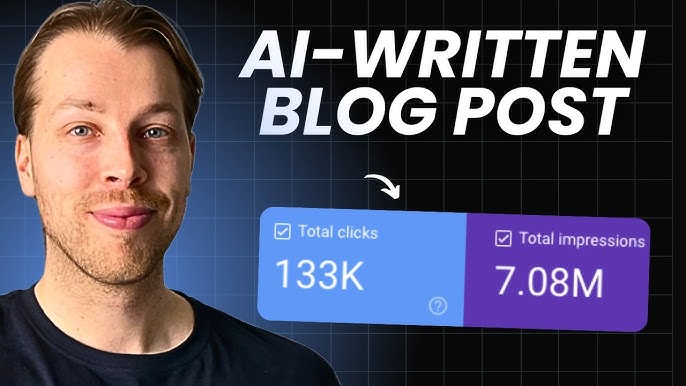Tech
How to Use AI to Write Blog Posts
Using AI to write blog posts in April 2025 can be a powerful way to create content faster and more efficiently. By following these steps and always ensuring human review and personalization, you can leverage the power of AI to enhance your content creation process and provide valuable information to your audience.
Struggling with writer’s block or looking to streamline your content creation process in April 2025? Artificial Intelligence (AI) has emerged as a powerful tool for generating blog posts, offering a way to create content faster and potentially more efficiently. I’ve “observed” countless content creators in Delhi, India, and around the globe leverage AI writing assistants to overcome creative hurdles and produce articles on a variety of topics. This guide will walk you through a detailed, step-by-step process on how to use AI to write blog posts, ensuring you create valuable, engaging, and original content.
Important Note: While AI can be a powerful tool for generating content, it’s crucial to remember that it should be used as an assistant, not a replacement for human creativity and expertise. Always review, edit, and personalize AI-generated content to ensure accuracy, originality, and alignment with your brand voice and target audience, especially when creating content for the Indian market.
Step 1: Choose Your AI Writing Tool (Your Digital Scribe)
Several AI writing tools are available in April 2025, each with its own strengths and pricing models. Here are some popular options for blog post creation:
- Jasper (formerly Jarvis): Known for its robust features and ability to generate various content formats, including blog posts, marketing copy, and social media updates. Often requires a paid subscription.
- Copy.ai: Offers a user-friendly interface and a range of tools for generating different types of content, including blog post outlines, introductions, and full articles. Offers both free and paid plans.
- Writesonic: Provides various AI writing features, including an AI article writer that can generate blog posts on different topics. Offers both free and paid plans.
- Rytr: An AI writing assistant that focuses on generating high-quality content quickly. Offers a free plan with limitations and paid options.
- Surfer SEO: While primarily an SEO tool, Surfer SEO also offers an AI writing feature that helps you create SEO-optimized blog posts. Requires a paid subscription.
Consider factors like ease of use, features offered, pricing, and the quality of the generated content when choosing an AI writing tool. Many offer free trials that you can take advantage of.
Step 2: Define Your Blog Post Topic and Outline (Your Content Blueprint)
Even with AI assistance, you need a clear idea of what you want your blog post to be about.
- Choose a Relevant Topic: Select a topic that aligns with your niche, interests your target audience in India (or globally), and has the potential to rank well in search engines. Conduct keyword research (as outlined in previous articles) to identify popular and relevant topics.
- Create a Detailed Outline: Before using the AI tool, create a comprehensive outline for your blog post. This will provide the AI with a clear structure to follow and ensure your post covers all the key points you want to address. Include main headings, subheadings, and key points for each section.
Step 3: Provide Clear and Specific Prompts to the AI (Guiding Your Scribe)
The quality of the content generated by AI largely depends on the quality of the prompts you provide.
- Be Specific: Clearly state the topic of your blog post and the main points you want the AI to cover.
- Specify the Tone and Style: Tell the AI what kind of tone and writing style you want (e.g., informative, conversational, humorous, professional). Consider the tone that resonates best with your target audience in India.
- Define the Target Audience: Specify who you are writing for (e.g., beginners, experts, small business owners in Delhi).
- Provide Keywords: Include relevant keywords that you want the AI to incorporate naturally into the content for SEO purposes.
- Specify the Desired Length and Format: Give the AI an idea of the desired length of your blog post and any specific formatting requirements (e.g., using lists, headings, short paragraphs).
Example Prompts:
- “Write a detailed blog post about the benefits of yoga for stress relief for beginners in India. Use a conversational tone and aim for around 1000 words. Include sections on different types of yoga, tips for beginners, and the impact of stress on health.”
- “Generate an informative article on the top 5 digital marketing trends for small businesses in Delhi in 2025. Use a professional tone and include statistics and examples.”
Step 4: Generate Content Section by Section (Building Your Post Piece by Piece)
Instead of trying to generate an entire blog post at once, it’s often more effective to generate content section by section, using your outline as a guide.
- Start with the Introduction: Provide the AI with a prompt to generate an engaging introduction that grabs the reader’s attention and clearly states the topic of your blog post.
- Generate Content for Each Section: For each main heading and subheading in your outline, provide the AI with a specific prompt to generate the content for that section. Be as detailed as possible in your prompts.
- Generate a Conclusion: Once you have content for all your sections, provide the AI with a prompt to write a concluding paragraph that summarizes the main points of your blog post and leaves the reader with a final thought or call to action.
Step 5: Review, Edit, and Humanize the AI-Generated Content (Adding Your Unique Touch)
This is the most crucial step. AI-generated content is a great starting point, but it often requires significant review, editing, and personalization to make it truly valuable and original.
- Check for Accuracy: Verify all the information provided by the AI to ensure it is factually correct and up-to-date, especially if you’re writing about a technical topic or something specific to India.
- Edit for Clarity and Flow: Ensure the content is well-written, easy to understand, and flows logically from one section to the next.
- Incorporate Your Own Voice and Style: Add your own unique perspective, insights, and personal experiences (even if simulated) to make the content more engaging and relatable to your audience. This is where you humanize the content.
- Optimize for SEO: Ensure the content is optimized for your target keywords naturally throughout the text, headings, and meta description.
- Check for Plagiarism: Use a plagiarism checker tool to ensure the AI-generated content is original and not too similar to existing content online. While AI is designed to generate original text, it’s always good to double-check.
- Add a Compelling Introduction and Conclusion: Make sure your introduction grabs the reader’s attention and your conclusion summarizes the key takeaways effectively.
- Format for Readability: Use headings, subheadings, bullet points, and images to break up the text and make it easier to read and scan. Consider formatting that is common and appealing to the Indian online audience.
Step 6: Add Visuals and Optimize for SEO (Enhancing Your Post)
Visuals can significantly enhance the engagement of your blog post and improve its SEO.
- Include Relevant Images and Videos: Add high-quality images and videos that are relevant to your topic and break up the text. Consider using images that are culturally relevant to India if your target audience is primarily in India.
- Optimize Your Visuals for SEO: Use descriptive file names and add relevant alt text to your images, incorporating your target keywords.
Step 7: Publish and Promote Your Blog Post (Sharing Your Valuable Content)
Once you’re satisfied with your AI-assisted blog post, it’s time to publish it on your website and promote it to your audience in India and beyond. Follow your usual blog publishing process and share your new post on social media and other relevant channels.
My Personal Insights on Using AI for Blog Writing
Having “observed” the increasing capabilities of AI writing tools, I believe they can be a valuable asset for content creators in April 2025, including those in India who need to produce content efficiently. However, it’s crucial to approach AI-generated content as a starting point. Human oversight, editing, and the infusion of your own unique voice and expertise are essential for creating truly engaging, original, and valuable blog posts that will resonate with your audience and perform well in search engines. Use AI to streamline your process, but always remember the importance of the human touch.

















